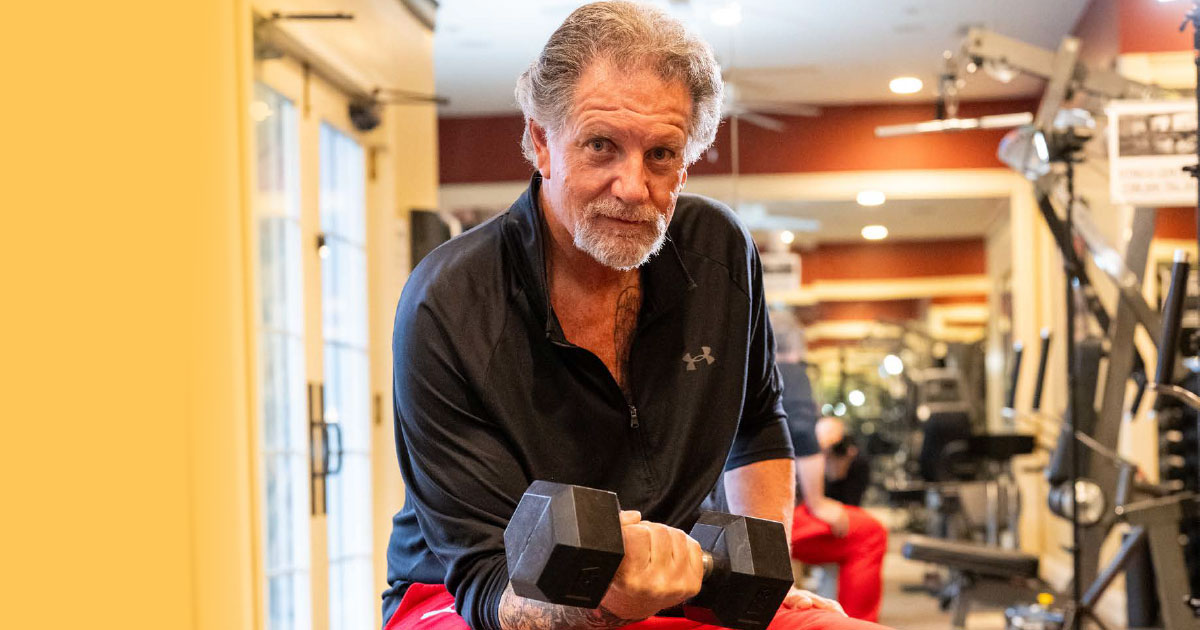“My wife, Patty, said it was the best decision she ever heard me make.”

A transformative surgery and lifestyle changes help a man lose 140 pounds.
A knee injury back in 1987 had set off a devastating snowball effect for Walter (Walt) O’Neill. First it ended his careers as both a police officer and a winning athlete. Then the five-time national champion and all-American in karate steadily gained weight over the decades that followed, which included 27 knee surgeries that eventually allowed him to become more mobile.
Seeking comfort in eating, Walt, who stands 6 feet, 2 inches, grew to well over 300 pounds. “It was all unhealthy foods and bad eating habits,” the Ocean Township resident recalls. “I was eating lots of fried food, often late at night, and getting no vegetables. And I wasn’t listening to people who cared about me and who told me to stop.”
Even a near-fatal “widow-maker” heart attack in 2016—caused by a complete blockage of the heart’s largest artery—didn’t turn Walt’s habits around. He tried dieting, but nothing stuck for long. “I kept slipping back to my old habits and forgetting why I was trying to get healthy,” he says.
It took another six years before Walt was jolted into realizing his weight was preventing him from living not only a healthy life, but also a fulfilling one. During a trip to an amusement park with two young granddaughters in summer 2022, a park employee told Walt that he was too large to fit on a ride with one of them and had to get off.
“I let my granddaughter down, and I let myself down,” says Walt, now 64. “I should never have let myself be in that situation. I was 360 pounds.”
Extensive Preparation

As soon as Walt got back to his hotel, he started plotting a healthier course. A major part of it, he decided, would be to undergo bariatric, or weight loss, surgery.
When he consulted with Michael Jaronczyk, MD, a member of the Weight Loss and Bariatric Surgery team at Monmouth Medical Center and Community Medical Center, Walt already had a procedure in mind. He wanted a sleeve gastrectomy, which removes about 80 percent of the stomach and leaves a tubular “sleeve” about the size of a banana. The procedure is the most commonly performed weight loss surgery in the United States.
Dr. Jaronczyk readily agreed that bariatric surgery made sense for Walt, and the pair hit it off. “Patients do very well with the gastric sleeve since it makes you feel fuller sooner, but most of the results are due to hard work,” says Dr. Jaronczyk. “Surgery is a tool we give patients to be successful along with dieting and exercise, but surgery doesn’t work without those lifestyle efforts.”
Walt had to commit to several pre-surgical requirements. One was to work with a registered dietitian to lose at least 20 pounds. He also agreed to stop smoking cigars and give up caffeinated drinks and sugar. And he underwent a thorough medical workup.
Walt further attended support group meetings that offered tips and insights to help him transform his body and lifestyle. “In order to be successful, you need to be around people who have gone through it,” he says.
About three weeks before his surgery, Walt took care of another crucial task: telling his family about his plans. He heard nothing but encouragement. “My wife, Patty, said it was the best decision she ever heard me make,” he says.
A Weight Loss All-Star
Walt underwent his bariatric procedure in February 2023 without any complications. Dr. Jaronczyk used a leading-edge device called a Titan stapler—which staples the newly created stomach sleeve shut “in one shot”—to complete the minimally invasive operation.
When Walt awakened, he was surprised to feel “no pain whatsoever” and proceeded to walk around the hospital hallways for about an hour. He went home the next morning.
Walt’s weight dropped quickly after surgery as he progressed from clear liquids to soft foods and then to a new-normal eating pattern. He learned to eat far smaller portions and to consume meals much more slowly. And he found he no longer craved foods that used to tempt him.
“I could eat a whole pizza before surgery,” he says. “Now I don’t even want a slice. Instead of potato chips, I eat carrots. A lot has to do with the fact that I don’t want to go back to the size I was.”
Regular exercise includes walking on a treadmill, pedaling a bike and lifting weights. “When you’re lighter and nothing hurts, it feels like you can do everything again,” he says.
Dr. Jaronczyk describes Walt as a model patient. “He really hit the ground running,” he says. “Walt has been an all-star patient the whole way. He’s setting the bar for others.”
Now 140 pounds lighter, Walt is adjusting to his new size and relishes moving around with no pain. He loves how weight loss has allowed him to stop taking all prior medications except baby aspirin for his heart.
The head of security for a local school district, Walt envisions returning with his grandchildren to the amusement park—where he’ll easily be able to accompany them on rides.
Learn more about weight loss surgery at RWJBarnabas Health.
